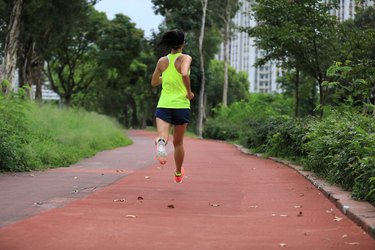
In the battle of tall runners vs. short runners, with all things being equal — body mass, flexibility, proportionality and stride rate — taller people can run faster than shorter people. However, the mechanics of running depends upon more than runner height.
Tip
The fastest runners apply the strongest force during each footstrike. Stride length and stride rate are both affected by the force of your footstrike, with shorter foot-to-ground contact resulting in a faster run. Long legs can help, but tall people do not necessarily run faster than shorter people.
Video of the Day
Tall Runners Vs. Short Runners
Stride length and frequency generally increase as your speed increases, advises PLOS One. While taller runners may have an advantage here as they usually have longer legs, proportionality impacts stride length, as two individuals of the same height, can have different leg lengths. Flexibility is also an important factor in a runner's stride length.
Video of the Day
The most significant factor influencing the running speed of elite runners is not the height of the runner, but the force of the runner's contact with the ground upon each footstrike, advises the Journal of Applied Physiology. The more powerful the strike to the ground, the faster the individual can run.
Running is a complex movement and no one characteristic, such as being tall, can make you run fast. Footstrike impact requires strength, and stride length further depends upon flexibility in your hips, quads and hamstrings.
Running Tips for Short Legs
Being shorter than your fellow runners may feel challenging, but with proper training and form, you can increase your running speed. Proper form requires balanced muscles and a strong core to ensure you are using your body efficiently. In addition, be sure to warm up and cool down properly before and after each workout.
The American Council on Exercise recommends no more than two high-intensity sessions each week. Balance your speed running program with strength training, endurance training and at least one day of rest and recovery.
Warning
Overtraining and poor mechanics can lead to injury and pain. If you experience pain while running, stop your workout and consult your doctor. Continuing to train with an injury may worsen the condition and result in longer recovery times.
When you run, keep your weight slightly forward with your spine straight, your head up and your eyes looking where you are going. Your arms and shoulders should be relaxed with your elbows bent at a 90-degree angle. Keep your knees relaxed and land on the middle of your foot with each stride. Avoid landing on your heel or letting your stride get too long as this places additional pressure on your joints.
Tip
To help you improve your running biomechanics and reduce the risk of injury, consider getting a gait analysis. You will run on a treadmill and a professional will analyze the video recording. This process evaluates your stride length, foot strike, the alignment of your feet, ankles and legs, core stability and arm movement. This knowledge can help you optimize your form and performance.
- Journal of Applied Physiology: "Are Running Speeds Maximized With Simple-Spring Stance Mechanics?"
- Southern Methodist University: "Key to Speed? Elite Sprinters Are Unlike Other Athletes — Deliver Forceful Punch to Ground"
- PLOS One: "Optimal Stride Frequencies in Running at Different Speeds"
- Wexner Medical Center: "What Do You Know About Your Running Gait?"
- American Council on Exercise: "Run Faster With Just 3 Workouts Per Week"
- A Healthier Michigan: "Improve Your Walking or Running Form in 3 Steps"